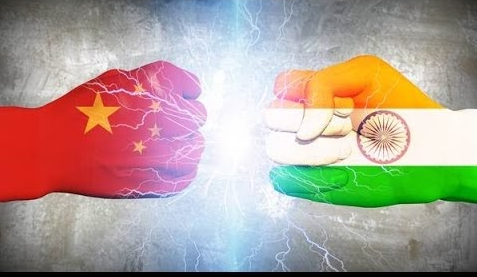A nation needs to have a strong and sustainable economy that does not wither away due to unknown circumstances. Given the current situation at the LAC with China, the common man is pompously advocating ‘ban Chinese products’ without knowing the fact that Chinese products particularly ‘technology’ constitutes a high percentage of the Indian market, for instance, almost 70% of the Indian smartphone market is constituted by Chines Brands namely Vivo, OPPO, Xiaomi etc, mobile chips, TV screen, hardware, fixtures, electronics and everything that we use in our daily life comes from China. The giant Chinese tech companies namely Alibaba, Tencent, ByteDance have invested enormously in Indian startups including PayTM, Swiggy, Policy Bazar, Oyo, Ola, Snapdeal, Udaan and many more. According to the United Nations COMTRADE database on international trade, China imports to India is worth $18.85B US Dollars.
While there is a movement on ‘banning chines products’, it appears more of a sentimental call rather than a well thought of strategy. It is important to realize the success factors behing the Chinese markets, to learn from the strategy that China is focusing on to become a superpower and dominate the global markets. One thing which stands out prominently is the focus of China on technology, innovation and R&D. Investment in technology-driven industries will lead us to become ‘Aatmanirbhar’.
The innovation and technology are a quintessential mechanism to boost the GDP of a nation which is in turn is dependent upon the modern intellectual property system in establishing an enabling environment for knowledge as well as technology-based economic development. Intellectual Property regime has immensely affected the socio-economic condition of a nation by propelling cultural, technological, and economic development. IPRs play a dual role, earlier they were recognized to reward the creator/inventor however in the modern time, they came to be recognized as a tool to spur economic growth of the countries.

Several reports across the globe reveal that the IPR intensive industries result in higher revenue, massive job creation, increase of international competitiveness, quality services, and higher wages. A study in 2019 [IPR-Intensive Industries and Economic Performace in the European Union] documented that almost 45% of the economic output and 30% of the jobs were generated by the IP intensive industires. In Ireland, 65% of the total GDP comes from the IP intensive Industries.
The contrast between the developing and developed countries can be studied in the light of their IP mechanism. The statistical analysis shows that the number of registered patents along with increased technology and innovation capacity, lead to greater FDI inflows. A study by OECD (2003) concluded that the IP rights particularly patents have a positive correlation with FDI and trade.
Reference to a few significant and exhaustive reports can be made to understand the importance of innovation and technology for an economy. The US Chamber released the 2020 International IP Index report which assessed the IP framework of 53 global economies that contributes 90% to the global GDP. The Index shows cross country analysis based on 50 unique indicators including education, innovation, infrastructure, R&D etc. which reflect the effectiveness of the IP regime in an economy. Few countries like Switzerland, Sweden, the US remain to be the most innovative whereas the intriguing thing is to look at the performance of China.
As per the report, China has been increasingly becoming technology and innovation dependent and focusing on higher valueadded knowledge and high tech advanced manufacturing. For over the past 15 years, China has increased its service sector by 25%, growing from 41.18% of GDP in 2004 to 52.16% of GDP in 2018 and decreased its industrial production and manufacturing.
Similarly, there is a massive increase in the number of patent applications from China [Patent Cooperation Treaty (PCT)] which is almost equal to the number of applications filed from the US in 2018., i.e. 53,345. China has the largest number of science and engineering graduates in the world and as a percentage of GDP, China invested 2.13% in R&D in 2017. However, China fails at several important indicators such as failure to address trade disputes and lack of adequate IP enforcement. Both China and India come under Asia but China features in Upper Middle-Income economies whereas India comes in Lower Middle-Income economies. The index score of both countries has increased with time. China ranks 28 on the index and India ranks 40 out of 53 economies. Another interesting report comes from the WIPO annually, known as Global Innovation Index [GII] which ranks the innovation performance of 130 economies. As per the 2019 report, China tops in the Upper Middle economy.
India’s rank has improved significantly from 81 in 2015 to 52 in 2019 and continues to be the most innovative economy in Central & Southern Asia. India consistently tops in innovation drivers such as ICT service exports, the quality of Universities particularly in science and technology cluster. This science and technology cluster [S&T] is an interesting parameter, these clusters are identified based on the locations of the inventors, authors appearing in the scientific journal articles. The data is taken from the Patent applications. The United States hosts the maximum no. of clusters [46] followed by China [18], Germany [10], France[5] and so on. Compared to last year all the Chinese clusters moved up in ranks. This reflects the improvement and development in innovation sector and scientific publications by Chinese entities.
Looking at the overall performance of the economies the report states that there is a shift in the gloral R&D trend, now it is not only the high-income economies carrying out R&D. In 2017, the share of high-income economies accounted for only 64% of global R& D whereas in 1996 they contributes 87% of global R & D.
Amongst the uppermiddle-income economies, China has increasingly contributed more in R& D as compared to other countries. In 1996, China contributed only 10% of the global R&D expenditures, whereas in 2017 it is 31%. China also continues to rise in the ranking from 17th in 2018 to 14th in 2019.
China remains the only middle-income economy in the top 30 and maintains top rank in high tech net imports and creative good imports.
The cumulative contribution of the Asian countries particularly China, Japan, Republic of Korea and India has also improved from 22% in 1996 to 40% in 2017 of the world’s R&D. Out of this 40%, China contributed the maximum which was 24% in 2017 as compared to only 2.6% in 1996.
Globally, if we look at different nation, one can easily decipher that different nations project their aspirations with different nomenclatures, such as ‘A Nation of Makers’ [USA], ‘Design in Innovation’ [UK], ‘Made in China 2025’ [China],’ Smart Nation’ [Singapore], ‘Made in India’ [India], ‘Creative Economy’ [Republic of Korea], ‘Thailand 4.0’ [Thailand] and so on, but one thing that is common across these economics is the shift towards the service and technology-based industries.
Where does a country stand in the Global IP index reveals a lot about its economy. Such as though on several parameters, India positions in the top of the raking amongst the lowerincome economies but globally we need to push ourselves a lot.
Starting with the education system, the learning has to be more outcomebased with an emphasis more on the ‘creation’ rather than just the ‘knowledge’ aspect. Every year thousands of Ph.Ds are awarded but how many of them are converted into a product or a system which can be applied industrially is the moot question. Innovation is a mindset which needs to be developed.
Although India stands third in the list of holding the largest group of scientists and technicians in the world as per the report and is predicted to be the largest supplier of the university graduate by this year, it fails to feature in the top 25 in the innovation parameter, which raises serious doubt on our entire learning and education system.
Having said that, it is also true that Indian economy is heavily supported by a skilled workforce and the government policies and initiatives such as Digital India, Atal Innovation Mission, Make in India, Skill India and Startup India, strongly strive to transform the economy to adapt to technology and innovation which propels the rise in the living standard of the citizens and to position India at par with other strong economies.
According to an update by DIPP in 2018, in pursuance to the objectives laid down in the National IPR Policy, 2016, around 40+ additional IPR initiatives have already been designed to foster IP driven systems. Since the release of the Policy, India has made remarkable efforts in spreading awareness on the negative impact of piracy and counterfeits.
The US Chamber report also appreciated that India has passed a series of reforms strengthing IP enforcement, addressed administrative inefficiencies, courts have imposed hefty fines for infringement. It also stated that India has made progress since 2012 in combating copyright piracy by issuing dynamic injunction orders, increasing penalty for IP infringement, new pilot patent p r o s e c u t i o n h i ghway [PPH] programme and increased R & D in IP based industries.
However, in September 2019, a study by Music Industry along with Delloite stated that piracy in the Indian Music industry accounts to a loss of approximately USD 250 Million a year. Another interesting research published in Quartz India in 2018 estimated that one out of three Indians received counterfeit from shopping online.
Needless to mention that stong innovation environment requires a robust IP legal framework including protection and enforcement because it incentivizes the innovators to invest in R&D.
India has a long way to go in this direction, we not only have to improve our R&D but also to have an effective IP regime. There are several serious hurdles particularly concerning copyright, piracy, patent eligibility, opposition, enforcement, compulsory licensing, data protection, transparency in search and seizures by customs and related issues which need special attention. It is high time that understanding of IPR issues shall reach masses. People should be able to realize the value of intellectual property rights and the rhetorics of ‘ban Chinese products’ shall be replaced by ‘Creative India and Innovative India’.
Dr. Vijay Kumar Singh is Dean and Charu Srivastava is Faculty at School of Law, UPES. Views are personal.























